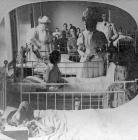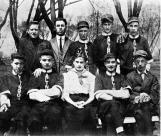1
In what was termed, "an audacious stroke" Elizabeth Neufeld was appointed as Headworker of Central Neighbourhood House. As a young Jewish woman from Baltimore, she was fluent in English, Yiddish, German and Polish. She took up residency within the community and shared in their everyday sorrows and gains during her four-year term. She advocated for better neighbourhood services - obtaining better street lighting, playgrounds and the use of schools as social centres: making strides in social progress that would set the tone for future directors.A hand-drawn map from the Headworker's 1912 annual report shows how Central Neighbourhood House, or CNH, for short, was located in the heart of the 'Ward,' at 84 Gerrard Street West - near the Elizabeth Street School Playground, the Yonge Streetcars and the Children's hospital.
From the library hour to the Arlington's athletic sports clubs, from folk dancing to monthly concerts and plays - the residents of the Ward now had a location to meet and nurture their sense of citizenship and culture.
Newsboys - who worked their late afternoon shifts in the city - could now gather once a week in the basement billiard room to rest from their day of hawking papers, also avoiding city lures of petty theft and gambling. Sales and factory girls who finished a long day on the assembly line could now meet once a week to share in sewing, and knitting classes, also selecting club leaders to promote independence and leadership.The Boys' Parliament provided the children with an initially rowdy introduction to concepts of citizenship. After dividing their neighbourhood into constituencies and electing a parliament, they borrowed money, purchased their baseball uniforms and levied fines of up to twenty-five cents for misdemeanors, such as smoking tobacco or using foul language.
Less than a year after it had opened, Elizabeth Neufeld's "Yearbook" leaflet summarized CNH's programming achievements. Over two hundred children and adults had participated in one of CNH's thirty-four clubs or activities at 84 Gerrard Street West.
CNH sports programming intensified in the 1920s as hockey teams from diverse Toronto settlement organizations competed for an annual trophy and celebrated their annual achievements with a hockey banquet. In May 1912, parents and friends gathered to watch their children showcase their acquired music, and folk dance skills at the first Central Neighbourhood House spring festival. With the enlisted help of the Parks Department,
some 250 geraniums were also distributed among the crowd of neighbours and families-these plants were to be nurtured and returned for judging in the fall. The festival scenes of celebration would have been hard to envision, a year earlier, when Arthur Burnett's Ward photographs shed light on the realities of Ward life and raised awareness of the need for settlement services.
2
Elizabeth Neufeld, first CNH Head Worker1910s
Central Neighbourhood House, Toronto
 Credits:
Credits:Central Neighbourhood House Records
3
Taking a break outside Central Neighbourhood House1918
Central Neighbourhood House, Toronto
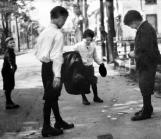 Credits:
Credits:Central Neighbourhood House Records
4
Winter play at Central Neighbourhood House1920s
Central Neighbourhood House, Toronto
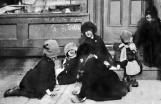 Credits:
Credits:Central Neighbourhood House Records
5
Girls' Club meeting at 349 Sherbourne Street1929
Central Neighbourhood House, Toronto
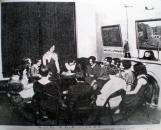 Credits:
Credits:Central Neighbourhood House Records
6
A hand-drawn map from the Headworker's 1912 annual report shows how Central Neighbourhood House, or CNH, for short, was located in the heart of the 'Ward,' at 84 Gerrard Street West - near the Elizabeth Street School Playground, the Yonge Streetcars and the Children's hospital.7
Map showing location of first Central Neighbourhood House on Gerrard Street West1910s
Central Neighbourhood House, Toronto
 Credits:
Credits:Central Neighbourhood House Records
8
Gymnastics at the Elizabeth Street Playground by Arthur Goss1917
Downtown Toronto
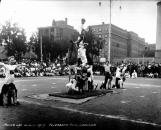 Credits:
Credits:City of Toronto Archives, 372-52-690
9
Elizabeth Street playground special event1910s
Downtown Toronto
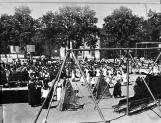 Credits:
Credits:Central Neighbourhood House Records
11
From the library hour to the Arlington's athletic sports clubs, from folk dancing to monthly concerts and plays - the residents of the Ward now had a location to meet and nurture their sense of citizenship and culture. Newsboys - who worked their late afternoon shifts in the city - could now gather once a week in the basement billiard room to rest from their day of hawking papers, also avoiding city lures of petty theft and gambling. Sales and factory girls who finished a long day on the assembly line could now meet once a week to share in sewing, and knitting classes, also selecting club leaders to promote independence and leadership.The Boys' Parliament provided the children with an initially rowdy introduction to concepts of citizenship. After dividing their neighbourhood into constituencies and electing a parliament, they borrowed money, purchased their baseball uniforms and levied fines of up to twenty-five cents for misdemeanors, such as smoking tobacco or using foul language12
Learning English at Central Neighbourhood House1913
Central Neighbourhood House, Toronto
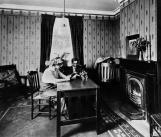 Credits:
Credits:Central Neighbourhood House Records
14
Central Neighbourhood House multicultural clubs1925
Central Neighbourhood House, Toronto
 Credits:
Credits:Central Neighbourhood House Records
